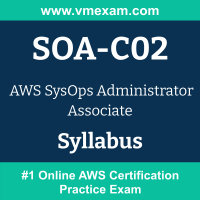|
Monitoring, Logging, and Remediation |
- Implement metrics, alarms, and filters by using AWS monitoring and logging services
-
Identify, collect, analyze, and export logs (for example, Amazon CloudWatch Logs, CloudWatch Logs Insights, AWS CloudTrail logs)
-
Collect metrics and logs by using the CloudWatch agent
-
Create CloudWatch alarms
-
Create metric filters
-
Create CloudWatch dashboards
-
Configure notifications (for example, Amazon Simple Notification Service [Amazon SNS], Service Quotas, CloudWatch alarms, AWS Health events)
- Remediate issues based on monitoring and availability metrics
-
Troubleshoot or take corrective actions based on notifications and alarms
-
Configure Amazon EventBridge rules to invoke actions
-
Use AWS Systems Manager Automation runbooks to take action based on AWS Config rules
|
20% |
|
Reliability and Business Continuity |
- Implement scalability and elasticity
-
Create and maintain AWS Auto Scaling plans
-
Implement caching
-
Implement Amazon RDS replicas and Amazon Aurora Replicas
-
Implement loosely coupled architectures
-
Differentiate between horizontal scaling and vertical scaling
- Implement high availability and resilient environments
-
Configure Elastic Load Balancing (ELB) and Amazon Route 53 health checks
-
Differentiate between the use of a single Availability Zone and Multi-AZ deployments (for example, Amazon EC2 Auto Scaling groups, ELB, Amazon FSx, Amazon RDS).
-
Implement fault-tolerant workloads (for example, Amazon Elastic File System [Amazon EFS], Elastic IP addresses)
-
Implement Route 53 routing policies (for example, failover, weighted, latency based)
- Implement backup and restore strategies
-
Automate snapshots and backups based on use cases (for example, RDS snapshots, AWS Backup, RTO and RPO, Amazon Data Lifecycle Manager, retention policy)
-
Restore databases (for example, point-in-time restore, promote read replica)
-
Implement versioning and lifecycle rules
-
Configure Amazon S3 Cross-Region Replication (CRR)
-
Perform disaster recovery procedures
|
16% |
|
Deployment, Provisioning, and Automation |
- Provision and maintain cloud resources
-
Create and manage AMIs (for example, EC2 Image Builder)
-
Create, manage, and troubleshoot AWS CloudFormation
-
Provision resources across multiple AWS Regions and accounts (for example, AWS Resource Access Manager [AWS RAM], CloudFormation StackSets, IAM cross-account roles)
-
Select deployment scenarios and services (for example, blue/green, rolling, canary)
-
Identify and remediate deployment issues (for example, service quotas, subnet sizing, CloudFormation errors, permissions)
- Automate manual or repeatable processes
|
18% |
|
Security and Compliance |
- Implement and manage security and compliance policies
-
Implement IAM features (for example, password policies, multi-factor authentication [MFA], roles, SAML, federated identity, resource policies, policy conditions).
-
Troubleshoot and audit access issues by using AWS services (for example, CloudTrail, IAM Access Analyzer, IAM policy simulator)
-
Validate service control policies (SCPs) and permissions boundaries
-
Review AWS Trusted Advisor security checks
-
Validate AWS Region and service selections based on compliance requirements
-
Implement secure multi-account strategies (for example, AWS Control Tower, AWS Organizations)
- Implement data and infrastructure protection strategies
|
16% |
|
Networking and Content Delivery |
- Implement networking features and connectivity
-
Configure a VPC (for example, subnets, route tables, network ACLs, security groups, NAT gateway, internet gateway)
-
Configure private connectivity (for example, Systems Manager Session Manager, VPC endpoints, VPC peering, VPN)
-
Configure AWS network protection services (for example, AWS WAF, AWS Shield)
- Configure domains, DNS services, and content delivery
-
Configure Route 53 hosted zones and records
-
Implement Route 53 routing policies (for example, geolocation, geoproximity)
-
Configure DNS (for example, Route 53 Resolver)
-
Configure Amazon CloudFront and S3 origin access control (OAC)
-
Configure S3 static website hosting
- Troubleshoot network connectivity issues
-
Interpret VPC configurations (for example, subnets, route tables, network ACLs, security groups)
-
Collect and interpret logs (for example, VPC Flow Logs, ELB access logs, AWS WAF web ACL logs, CloudFront logs).
-
Identify and remediate CloudFront caching issues
-
Troubleshoot hybrid and private connectivity issues
|
18% |
|
Cost and Performance Optimization |
- Implement cost optimization strategies
-
Implement cost allocation tags
-
Identify and remediate underutilized or unused resources by using AWS services and tools (for example, Trusted Advisor, AWS Compute Optimizer, AWS Cost Explorer)
-
Configure AWS Budgets and billing alarms
-
Assess resource usage patterns to qualify workloads for EC2 Spot Instances
-
Identify opportunities to use managed services (for example, Amazon RDS, AWS Fargate, Amazon EFS)
- Implement performance optimization strategies
-
Recommend compute resources based on performance metrics
-
Monitor Amazon Elastic Block Store (Amazon EBS) metrics and modify configuration to increase performance efficiency.
-
Implement S3 performance features (for example, S3 Transfer Acceleration, multipart uploads)
-
Monitor RDS metrics and modify the configuration to increase performance efficiency (for example, Performance Insights, RDS Proxy)
-
Enable enhanced EC2 capabilities (for example, Elastic Network Adapter, instance store, placement groups).
|
12% |
 The AWS SOA-C02 exam preparation guide is designed to provide candidates with necessary information about the SysOps Administrator Associate exam. It includes exam summary, sample questions, practice test, objectives and ways to interpret the exam objectives to enable candidates to assess the types of questions-answers that may be asked during the AWS Certified SysOps Administrator - Associate exam.
The AWS SOA-C02 exam preparation guide is designed to provide candidates with necessary information about the SysOps Administrator Associate exam. It includes exam summary, sample questions, practice test, objectives and ways to interpret the exam objectives to enable candidates to assess the types of questions-answers that may be asked during the AWS Certified SysOps Administrator - Associate exam.